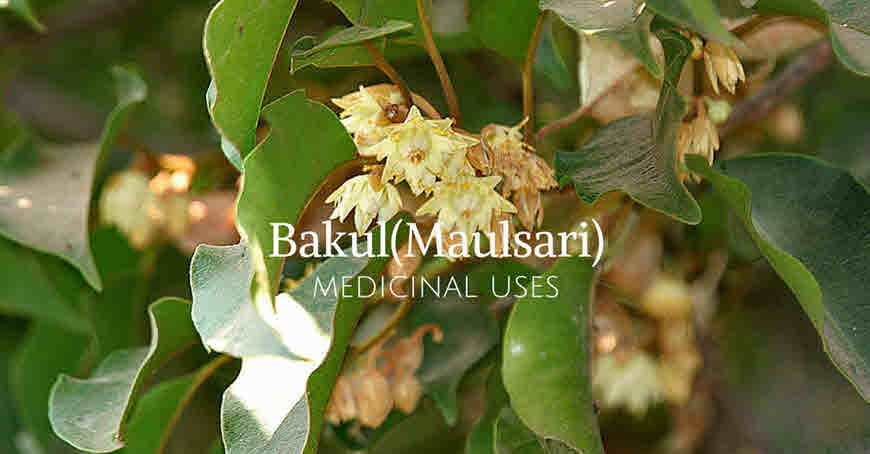Mimusops elengi (Indian Medlar, Bulletwood tree, Bakul or Maulsari) is an evergreen tree with sweet scented flowers and it is often grown as garden tree. It is a medicinal tree with edible parts. This tree is especially useful in treating gum problems and dental disorders such as bleeding gums, loose teeth, sensitive teeth, cavities, etc. Its tender parts are used as tooth brush. The bark and seed coat are used for strengthening the gum. It is used under the name of Vajradanti, in preparation of various herbal tooth powders along with many other ingredients such as catechu, pomegranate bark, etc. Its fruits are eaten raw and also prepared as pickle. The bark of the tree is used to improve fertility in women. The fruits are edible and used to treat chronic dysentery. They have astringent action. The seeds exhibits purgative action.

Scientific Classification
The botanical name of Bakul/Maulsiri is Mimusops elengi and it belongs to the family Sapotaceae;Mahua-family (Plant family Sapotaceae consists of trees/ shrubs with milky latex. It include about 70 genera and 800 species. The characteristic feature of member of this family is presence of reddish brown hairs on the leaf undersides and other plant surfaces). Its taxonomic classification is as given below:-
- Kingdom: Plantae
- Subkingdom: Viridiplantae
- Infrakingdom: Streptophyta – land plants
- Superdivision: Embryophyta
- Division: Tracheophyta– vascular plants
- Subdivision: Spermatophytina spermatophytes, seed plants
- Class: Magnoliopsida
- Superorder Asteranae
- Order: Ericales
- Family: Sapotaceae – sapodillas, sapotes
- Genus: Mimusops L.
- Species: Mimusops elengi L. – Spanish cherry
Vernacular names
Ayurvedic/Sanskrit: Anangaka, Bakula, Chirapushpa, Dhanvi, Gudhpushpa, Kantha, Karuka, Kesha, Mukula, Padyamoda, Sharadika, Sindhugandha, Simhakeshaa, Sthirmukhgandha, Surabhi Tailanga, Varalahdha, Visharada
- UNANI: Maulsiri, GUJARATI: Babhuli, Bolsari, Varsoli, Vovoli
- HINDI: Bakul, Bolsari, Maulsarau, Maulser, Maulsari
- TAMIL: Alagu, Ilangi, Kesaram, Kosaram, Magil, Magilam, Vagulam
- TELUGU: Pogada
- KANNADA: Pagademara
- PUNJABI: Maulsari, Maulsiri
- BENGALI: Bakal, Bakul, Bohl, Bukal
- MARATHI: Bakhor, Bakula, Barsoli, Ovalli, Owli, Vavoli, Wovali, Wowli
- MALAYALAM: Elengi, Ilanni, Iranni, Makuram, Bakulam
- NEPALESE: Bakulapuspa
- SINHALESE: Munemal
- GERMAN: Affengesict
- FRENCH: karanicum, BURMESE: Kaya, MALAYSIAN: Enengi, THAI: Pikul
- ENGLISH: Spanish-Cherry, West Indian Medlar, Bullet Wood
- TRADE NAME: Bulletwood
Distribution in India
Mimusops elengi tree is the native of India.
It is cultivated in North and Peninsular India and Andaman Islands. It is grown as an avenue tree in many parts of India.
Tree description
Large evergreen tree with dark grey fissured bark and densely spreading crown;Leaves oblong, glabrous and leathery with wavy margins, Flowers white, fragrant, axillary, solitary or fascicled, Fruits ovoid or ellipsoid berries, Seeds 1-2 per fruit, ovoid, compressed, greyish brown and shiny.
Propagation: by seeds and cutting
Main Constituents
Leaves: sterols, reducing sugars and tannins, Roots: a steroidal saponin, Stem bark: spinasterol and taraxerol, flowers, D-mannitol, beta-sitosterol and beta-sitosterol- D-glycoside;Seeds: pentacyclic triterpene acids, mimusopic and mimusopsic acids.
Part used: bark, flower, fruit, seeds
Medicinal Action of Various parts of Mimusops elengi (Bulletwood tree, Bakul or Maulsari) |
||
| Action | Meaning | Part of tree |
| Antiprotozoal | Destroys protozoa or inhibits their growth and ability to reproduce | Stem |
| Antimicrobial | Works against microbes | Bark |
| Antiviral | Works against virus | Bark |
| Antiulcer | Inhibits ulcer formation | Bark |
| Anthelmintic | Destroy parasitic worms | Leaf |
| Antipyretic | Fever reducing Leaf | Leaf |
| Anti-inflammatory | Reduce inflammation | Leaf, bark |
| Anti-hyperlipidemic | Acting to prevent or counteract the accumulation of lipids in the blood | Bark |
| Anti-hyperglycemic | Counteracting the accumulation of excess sugar in the blood | Bark |
| Antioxidant | Inhibits damaging oxidizing agents in a living cells | Leaf, fruit |
| Antihypertensive | Effective against high blood pressure | Leaf |
| Antiurolithiatic | Preventing the formation of the urinary calculi | Bark |
| Antidiabetic | Controls glucose level | Stem bark, Leaf |
| Analgesic | Pain relieving | Leaf |
| Antianxiety | Prevent or relieve anxiety | Bark |
| Anticonvulsant | Prevent or reduce the severity of epileptic fits or other convulsions | Bark |
| Diuretic | Increased passing of urine | Bark |
| Wound healing | Heals wound | Stem bark |
| Larvicidal activity | Kills larvae | Bark |
| Molluscicidal activity | Kills molluscs (mainly snails and slugs) | Leaf, Bark, Seed |
| Antiulcer | Inhibits formation of ulcer | Bark |
| Cardiotonic | tonic effect on the action of the heart | Bark |
Medicinal Uses of Bakul
Bulletwood tree, Bakul or Maulsari tree is a medicinal tree. For the medicinal purpose its leaves, fruit, bark and flowers are used. The flowers, bark and fruits are astringent in action. Bark is used as Tonic, astringent, and to reduce fever. The leaves are used as antidote to snake-bite. The pulp of the fruit is used in curing chronic dysentery. Dried flowers powder is used as a brain tonic. Seeds of the tree are purgative. The aerial parts are diuretic in action.
Tingling sensation of teeth:Massage gums with powdered bark.
Toothache, Tooth Decay, Gum Bleeding, Bad breath, Pyorrhea, Inflammation in the mouth:Decoction of bark is prepared and as used as mouth wash.
Toothache: Bark powder is applied.
Teeth cleaning, strengthening gums: Tender twigs are used for teeth cleaning.
Loose teeth: Unripe fruits are used as masticatory.
Improving fertility in women: Fruit pulp is eaten.
Promoting delivery: Ripe fruit is given to promote delivery.
Causing miscarriage or abortion: Fruits are sometimes used for abortion.
Eyesight weakness, Diseases of Eyes: 7-14 ml. leaf juice is taken twice daily with honey.
Brian tonic: The powder of dried flower is eaten as a brain tonic.
Chronic diarrhea, Weakness after diarrhea: The fruit pulp is eaten.
Headache:The dried flower powder is used a snuff in case of headache.
The Dosage of Maulsiri: Bark, Seed:10-20g paste and Decoction 50-100ml.